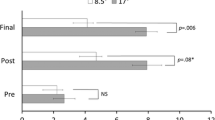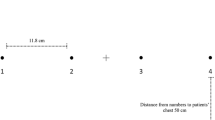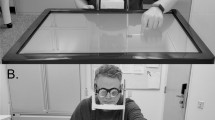Abstract
Wedge prisms shifting the visual field laterally create a mismatch between the straight ahead position signalled by vision and that encoded by extraretinal and head-on-trunk proprioceptive information. Short-term adaptation to left-deviating prisms in normal subjects results in a visuomotor attentional bias towards the right-hand side (aftereffect). Prismatic adaptation (PA) is usually induced through a training consisting in repeated ballistic movements of the dominant arm towards visual targets, while participants are wearing prismatic goggles. The present study demonstrates that an original oculomotor PA procedure with leftward deviating prisms—without pointing movements and only consisting in repeated gaze shifts towards visual targets—can induce a rightward bias in normal subjects as assessed by visual straight ahead and line bisection tasks (Experiments 1 and 2). We show that oculomotor PA induces a bias in line bisection similar to that reported after visuomotor PA (Experiment 2). We suggest that a conflict between retinal, extraretinal and proprioceptive information about the straight ahead location causes the observed effects. In follow-up experiments 3, 4, and 5, we demonstrate that neither eye deviation without prisms nor shift of the visual field without eye deviation induces PA biases. We propose that an optimal integration model of visual and proprioceptive inputs can best account for the observed results.






Similar content being viewed by others
References
Berberovic N, Mattingley JB (2003) Effects of prismatic adaptation on judgements of spatial extent in peripersonal and extrapersonal space. Neuropsychologia 41:493–503
Bisiach E (1997) The spatial features of unilateral neglect. In: Thier P, Karnath HO (eds) Parietal lobe contributions to orientation in 3D space. Springer, Heidelberg, pp 465–495
Bisiach E, Pattini P, Rusconi ML, Ricci R, Bernardini B (1997) Unilateral neglect and space constancy during passive locomotion. Cortex 33:313–322
Bultitude JH, Van der Stigchel S, Nijboer TC (2013) Prism adaptation alters spatial remapping in healthy individuals: evidence from double-step saccades. Cortex 49:759–770. doi:10.1016/j.cortex.2012.01.008
Chapman HL, Eramudugolla R, Gavrilescu M, Strudwick MW, Loftus A, Cunnington R, Mattingley JB (2010) Neural mechanisms underlying spatial realignment during adaptation to optical wedge prisms. Neuropsychologia 48:2595–2601. doi:10.1016/j.neuropsychologia.2010.05.006
Colent C, Pisella L, Bernieri C, Rode G, Rossetti Y (2000) Cognitive bias induced by visuo-motor adaptation to prisms: a simulation of unilateral neglect in normal individuals? Neuroreport 11:1899–1902
Craske B (1967) Adaptation to prisms: Change in internally registered eye-position. Br J Psychol 58:329–335
Ebenholtz SM (1976) Additivity of aftereffects of maintained head and eye rotations: An alternative to recalibration. Perception Psychophysics 19:113–116
Ernst MO, Banks MS (2002) Humans integrate visual and haptic information in a statistically optimal fashion. Nature 415:429–433. doi:10.1038/415429a
Ferber S, Danckert J, Joanisse M, Goltz HC, Goodale MA (2003) Eye movements tell only half the story. Neurology 60:1826–1829
Fortis P, Goedert KM, Barrett AM (2011) Prism adaptation differently affects motor-intentional and perceptual-attentional biases in healthy individuals. Neuropsychologia 49:2718–2727. doi:10.1016/j.neuropsychologia.2011.05.020
Girardi M, McIntosh RD, Michel C, Vallar G, Rossetti Y (2004) Sensorimotor effects on central space representation: prism adaptation influences haptic and visual representations in normal subjects. Neuropsychologia 42:1477–1487. doi:10.1016/j.neuropsychologia.2004.03.008
Harris CS (1963) Adaptation to displaced vision: visual, motor, or proprioceptive change? Science 140:812–813
Hay JC, Pick HL Jr (1966) Visual and proprioceptive adaptation to optical displacement of the visual stimulus. J Exp Psychol 71:150–158
Hay JC, Pick HL, Ikeda K (1965) Visual capture produced by prism spectacles. Psychon Sci 2:215–216
Jacquin-Courtois S, O’Shea J, Luaute J et al (2013) Rehabilitation of spatial neglect by prism adaptation: a peculiar expansion of sensorimotor after-effects to spatial cognition. Neurosci Biobehav Rev 37:594–609. doi:10.1016/j.neubiorev.2013.02.007
Michel C, Pisella L, Halligan PW, Luaute J, Rode G, Boisson D, Rossetti Y (2003) Simulating unilateral neglect in normals using prism adaptation: implications for theory. Neuropsychologia 41:25–39
Newport R, Preston C, Pearce R, Holton R (2009) Eye rotation does not contribute to shifts in subjective straight ahead: implications for prism adaptation and neglect. Neuropsychologia 47:2008–2012. doi:10.1016/j.neuropsychologia.2009.02.017
Rabuffetti M, Folegatti A, Spinazzola L, Ricci R, Ferrarin M, Berti A, Neppi-Modona M (2013) Long-lasting amelioration of walking trajectory in neglect after prismatic adaptation. Front Hum Neurosci 7:382 doi:10.3389/fnhum.2013.00382
Rock I, Goldberg J, Mack A (1966) Immediate correction and adaptation based on viewing a prismatically displaced scene. Percept Psychophysycs 1:351–354
Ronga I, Franza M, Sarasso P, Neppi-Modona M (in press) Oculomotor Prismatic Training is effective in ameliorating spatial neglect: a pilot study. Experimental Brain Research. doi:10.1007/s00221-017-4923-6
Rossetti Y, Rode G, Pisella L, Farne A, Li L, Boisson D, Perenin MT (1998) Prism adaptation to a rightward optical deviation rehabilitates left hemispatial neglect. Nature 395:166–169. doi:10.1038/25988
Schintu S, Pisella L, Jacobs S, Salemme R, Reilly KT, Farne A (2014) Prism adaptation in the healthy brain: the shift in line bisection judgments is long lasting and fluctuates. Neuropsychologia 53:165–170. doi:10.1016/j.neuropsychologia.2013.11.013
Serino A, Angeli V, Frassinetti F, Ladavas E (2006) Mechanisms underlying neglect recovery after prism adaptation. Neuropsychologia 44:1068–1078. doi:10.1016/j.neuropsychologia.2005.10.024
Striemer C, Sablatnig J, Danckert J (2006) Differential influences of prism adaptation on reflexive and voluntary covert attention. J Int Neuropsychol Soc 12:337–349
van Beers RJ, Sittig AC, Gon JJ (1999) Integration of proprioceptive and visual position-information: an experimentally supported model. J Neurophysiol 81:1355–1364
van Beers RJ, Wolpert DM, Haggard P (2002) When feeling is more important than seeing in sensorimotor adaptation. Curr Biol 12:834–837
Acknowledgements
The authors are grateful to Spatial Motor and Bodily Awareness (SaMBA) Group for the valuable discussion about the present research. We would like to acknowledge the contribution of Professor Ferdinando Rossi, who left us prematurely in January 2014. He provided us with precious insights and actively supported the initial phases of the project. IR, at the time of the experiments, was founded by a research grant (University of Turin, Italy) on the plasticity of adult human brain and, with Marco Neppi Modona, by a grant of the Italian Ministry of University and Scientific Research (MIUR), PRIN 2010ENPRYE_003.
Author information
Authors and Affiliations
Corresponding author
Ethics declarations
Conflict of interest
The authors declare that they have no conflict of interest.
Rights and permissions
About this article
Cite this article
Ronga, I., Sarasso, P., Raineri, F. et al. Leftward oculomotor prismatic training induces a rightward bias in normal subjects. Exp Brain Res 235, 1759–1770 (2017). https://doi.org/10.1007/s00221-017-4934-3
Received:
Accepted:
Published:
Issue Date:
DOI: https://doi.org/10.1007/s00221-017-4934-3




